Home Decor
What Is the Meaning of Home Decor
Step into the world of home decor, where furniture, accessories, and color schemes come together to transform living spaces – discover the magic within.
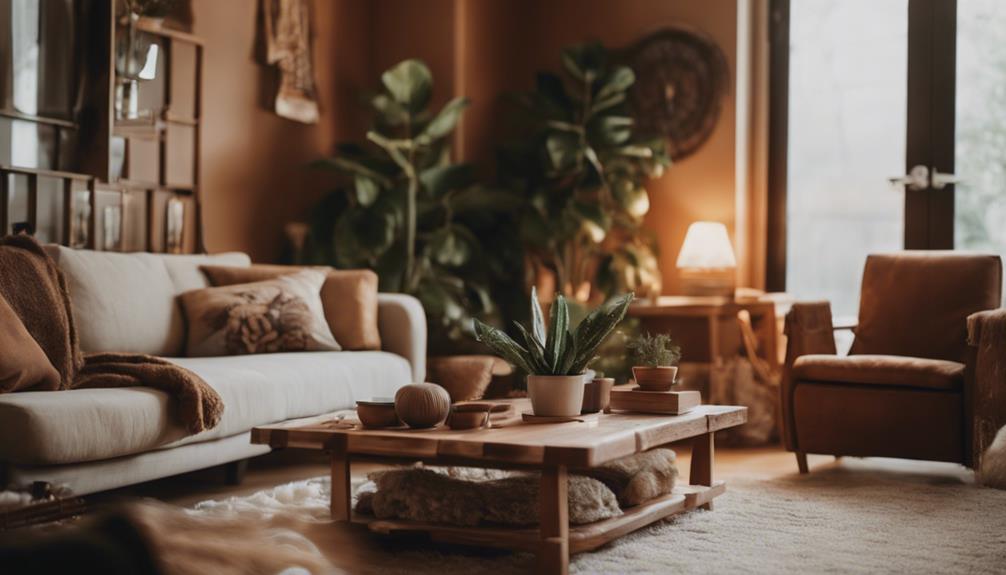
Home decor involves selecting furniture, accessories, and color schemes to make living spaces visually appealing and functional. It's about creating a cohesive environment that reflects personal style while ensuring practicality. Furniture defines style and function, accessories add personality, color schemes set the mood, and art pieces provide focal points. Incorporating personal items, using mirrors strategically, and playing with different textures can enhance the ambiance. However, avoiding overcrowding rooms, selecting the right size furniture, and paying attention to lighting are essential. To learn more insights about home decor and how to elevate your living space effectively, explore the elements, tips, ideas, and mistakes associated with it.
Key Takeaways
- Home decor involves selecting furniture, accessories, and colors to enhance a space's visual appeal.
- It encompasses interior design, focusing on aesthetics, functionality, and layout.
- Elements should be cohesive, practical, and reflective of personal style.
- Carefully choose furniture, decor items, and colors for a harmonious environment.
- Create a visually appealing and functional space by coordinating furniture, colors, and accessories.
Definition of Home Decor
When we talk about home decor, we're referring to how we choose and arrange furniture, accessories, and color schemes in our living spaces to enhance their visual appeal. Interior design is a key aspect of home decor, encompassing the layout, aesthetics, and functionality of a space. It's essential to make sure that the elements within a room not only look good together but also serve a practical purpose. By carefully selecting furniture pieces, decorative items, and coordinating colors, we can create a cohesive and visually pleasing environment that reflects our personal style.
Effective home decor goes beyond just aesthetics; it can greatly impact the overall atmosphere of a home. Thoughtfully designed spaces can promote relaxation, productivity, and a sense of well-being. As trends in home decor evolve, influenced by design movements and individual preferences, it's important to stay true to our own tastes and create a space that feels authentic to us. Ultimately, home decor is a form of self-expression that allows us to craft living spaces that resonate with who we are.
Elements of Home Decor
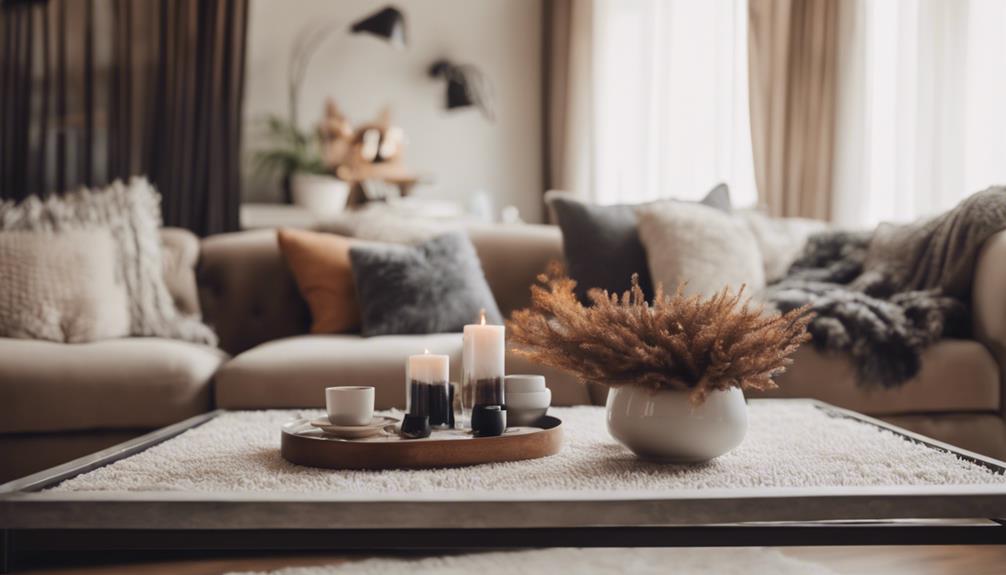
Exploring the various components that make up home decor reveals the intricate balance between furniture, accessories, color schemes, and art in shaping the aesthetic appeal of a living space. To create a harmonious and visually appealing atmosphere, these elements need to complement each other.
Here are four key components of home decor:
- Furniture: The choice of furniture, including sofas, chairs, tables, and storage units, plays a significant role in defining the style and functionality of a room.
- Accessories: Items like rugs, curtains, cushions, and lighting fixtures add personality and texture to a space, enhancing its overall look and feel.
- Color Schemes: The selection of colors for walls, furniture, and decor items sets the mood and tone of a room, influencing the perceived size and ambiance.
- Art: Paintings, sculptures, photographs, and other art pieces provide a focal point and contribute to the aesthetic appeal, reflecting the homeowner's taste and style preferences.
Tips for Home Decor
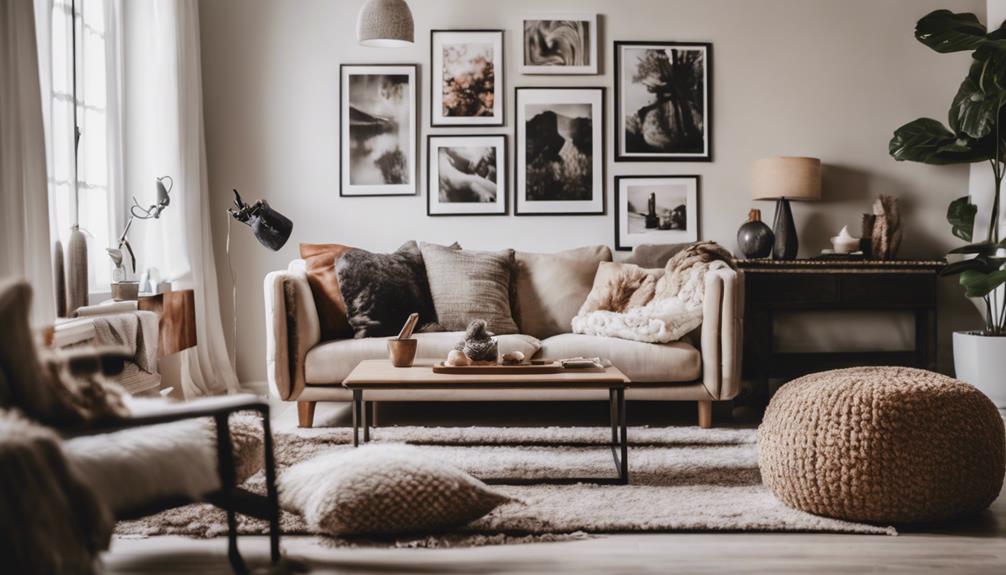
Incorporating personal items like family photos or heirlooms can add a unique touch to your home decor, making it truly yours. To enhance the appearance of your space, consider using mirrors strategically to create the illusion of more space and amplify natural light. Experimenting with different textures such as rugs, throws, and cushions can add depth and warmth to your decor, creating a cozy atmosphere.
When selecting furniture, opt for versatile pieces that can serve multiple functions to maximize space, especially in smaller rooms. Additionally, keep in mind the principles of color psychology when choosing paint colors and decor elements. Colors can influence emotions, so select hues that align with the desired atmosphere for each room.
Seasonal Home Decor Ideas
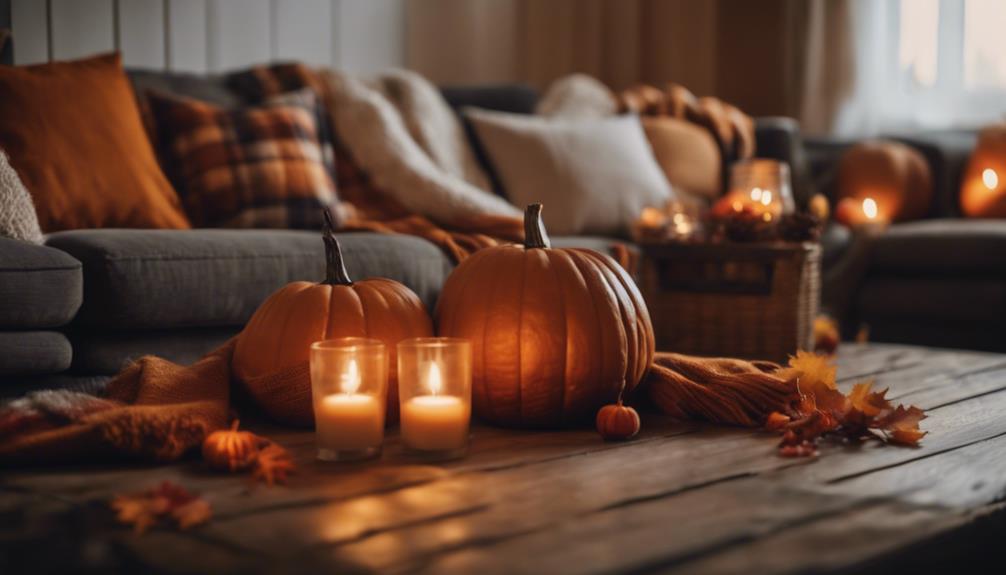
Let's explore how seasonal home decor ideas can effortlessly transform your living space.
- Spring Decluttering: Embrace the freshness of spring by decluttering your living area. Clear out unnecessary items to create a sense of openness and airiness.
- Fresh Flower Accents: Incorporate fresh flowers sparingly to bring a touch of nature indoors. Choose light and delicate blooms to add a pop of color and freshness to your space.
- Maximize Natural Lighting: Make the most of natural light during spring by using light colors in your decor. Opt for light-colored curtains, rugs, and furniture to enhance the brightness of your home.
- Subtle Blue Accents: Add subtle blue accents like throw pillows, vases, or wall art to evoke a sense of calm and serenity. Blue hues can create a peaceful atmosphere that complements the vibrant energy of spring.
Common Home Decor Mistakes
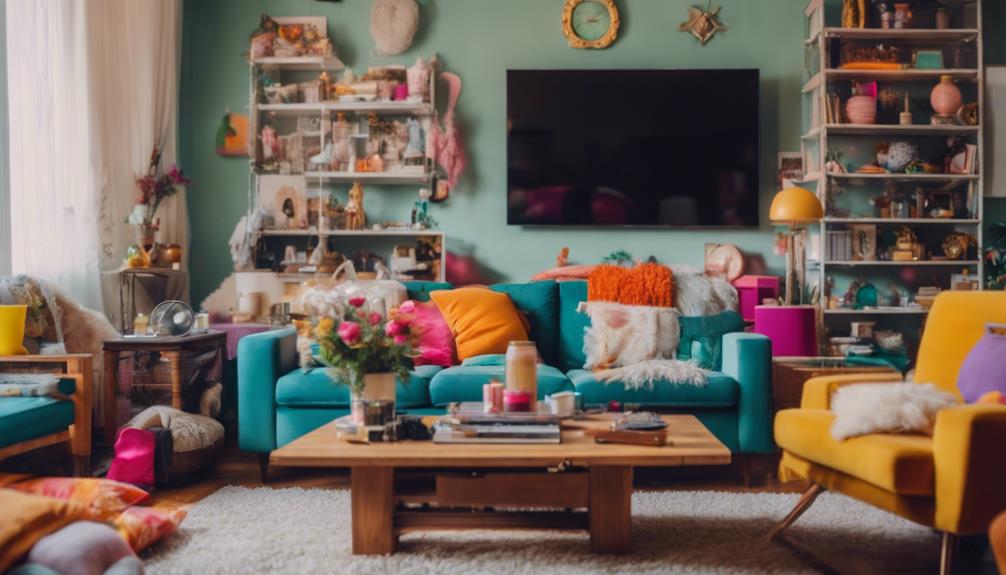
One of the most common mistakes in home decor is overcrowding rooms with furniture and accessories, resulting in a cluttered look. This can make a space feel cramped and chaotic, detracting from the overall aesthetic.
Another prevalent error is choosing the wrong size of furniture for a room, disrupting the balance and flow. It's important to take into account the dimensions of the space to make sure that furniture fits appropriately.
Neglecting proper lighting is also a frequent blunder that can make a room feel dull or overly bright, affecting the ambiance.
Additionally, using too many contrasting colors or patterns without cohesion can create visual chaos in home decor. It's vital to find a balance and establish a cohesive color scheme.
Lastly, ignoring the importance of scale and proportion in decor can lead to an unbalanced and unharmonious design. Paying attention to these details can greatly enhance the overall look and feel of a room.
Frequently Asked Questions
What Is the Significance of Home Decor?
Home decor holds significant importance as it shapes the ambiance of living spaces, making them more inviting and aesthetically pleasing. Well-executed decor can transform small areas into spacious and functional rooms, enhancing their overall appeal.
Investing in quality decor items not only adds value to a property but also allows for personal expression and creativity. Properly chosen elements can complement architectural features, elevating the design of a home and creating a personalized living environment.
What Is the Full Meaning of Decor?
When we talk about decor, we're referring to the style and arrangement of furnishings and decorations within a space. It encompasses everything from furniture to color schemes, shaping the overall look and feel of a room.
Decor plays an essential role in interior design, reflecting personal taste and creating a welcoming environment. By paying attention to decor, we can transform a house into a home that truly reflects our unique style and personality.
What Is the Best Description of Home Decor?
When considering home decor, the best description revolves around the selection and arrangement of furniture, accessories, and color schemes to enhance a living space's aesthetics.
It involves creating a visually appealing atmosphere that reflects personal style and functionality. Effective decor choices can greatly impact the overall look and feel of a home, contributing to a harmonious and comfortable environment for residents.
What Is Home Decor Examples?
When considering home decor examples, think of furniture, accessories, color schemes, artwork, and lighting choices. These elements contribute to various styles like contemporary, modern, Hamptons, Scandi, and shabby chic designs.
Home decor is important for creating a visually appealing and harmonious living space, enhancing both the functionality of a room and the quality of residents' lives.
Trends in home decor evolve over time, reflecting design movements, cultural influences, and societal preferences.
Conclusion
To sum up, home decor is the art of enhancing and beautifying living spaces through various design elements and personal touches. By incorporating different styles, colors, textures, and accessories, you can create a space that reflects your personality and makes you feel comfortable and at home.
Whether it's adding a pop of color with throw pillows or rearranging furniture for better flow, home decor is all about creating a space that you love to live in. Stay tuned for more tips and ideas to elevate your home decor game!
Wall Art and Decor
Is It Easy to Paint Interior
With the right tools and techniques, painting the interior of your home can be a rewarding experience – find out the key to success!
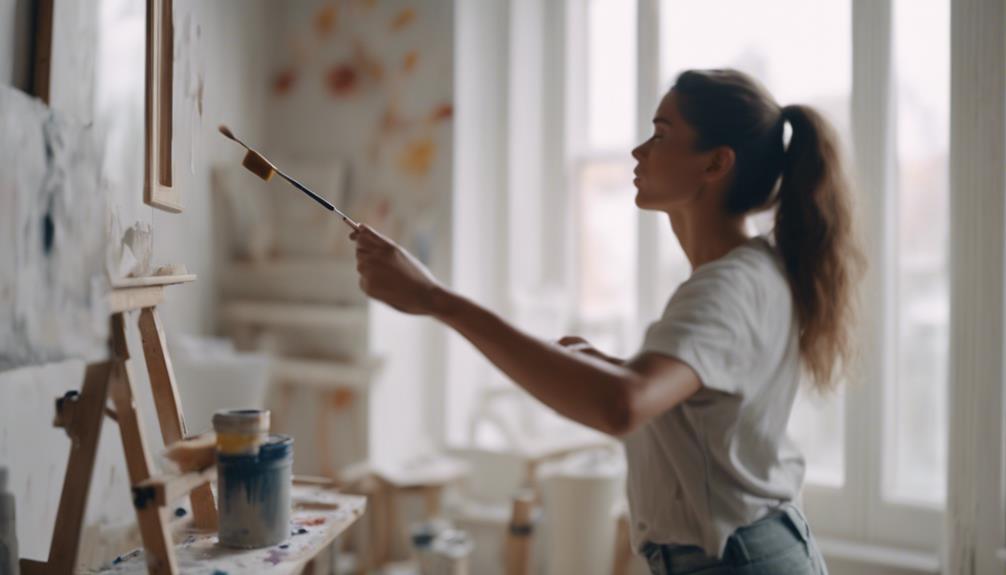
Painting the interior of your home is achievable when you have the right tools and know-how. Invest in quality paint supplies like rollers and brushes, use drop cloths to protect surfaces, and prep the room by cleaning walls and moving furniture. Applying multiple thin coats, starting from the top, and using proper techniques will lead to a professional finish. Remember to take your time, avoid common mistakes, and clean up carefully for a successful project. With the right preparation and techniques, painting your interior can be a rewarding and satisfying experience.
Key Takeaways
- Proper tools and preparation make interior painting easier and more successful.
- Choosing the right paint type and finish simplifies the painting process.
- Following best painting techniques ensures a smooth and professional outcome.
- Avoiding common mistakes like overworking paint leads to an easier painting experience.
- Completing final touches and clean-up properly marks the end of an easy interior painting project.
Key Tools for Interior Painting
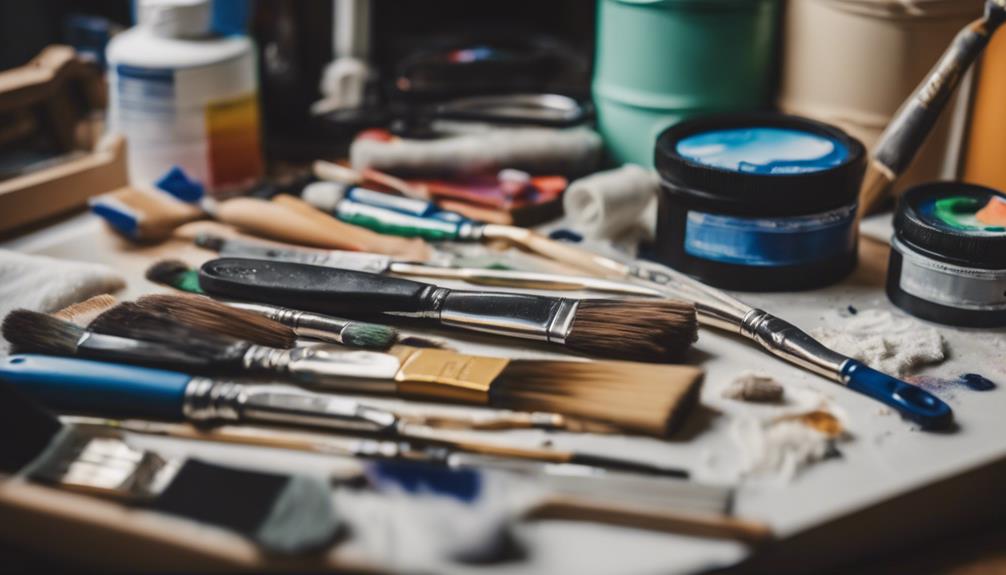
When starting an interior painting project, you'll find that having the right tools is essential for achieving professional results. To paint your walls efficiently, invest in high-quality paint rollers that can cover large areas smoothly. These rollers come in various sizes to suit different wall surfaces.
Additionally, using drop cloths to protect your floors and furniture from paint spills is important. These cloths can easily be spread out to catch any paint drips, keeping your surroundings clean and mess-free.
Having the right tools, like quality brushes and paint trays, guarantees that your paint application is even and consistent. Paint edgers are also necessary for creating clean lines along edges and corners, giving your walls a polished look.
Investing in these tools may seem like an added expense, but they make the painting process easier and more efficient in the long run. Remember, the right tools can greatly impact the final outcome of your interior painting project.
Choosing the Right Paint Color
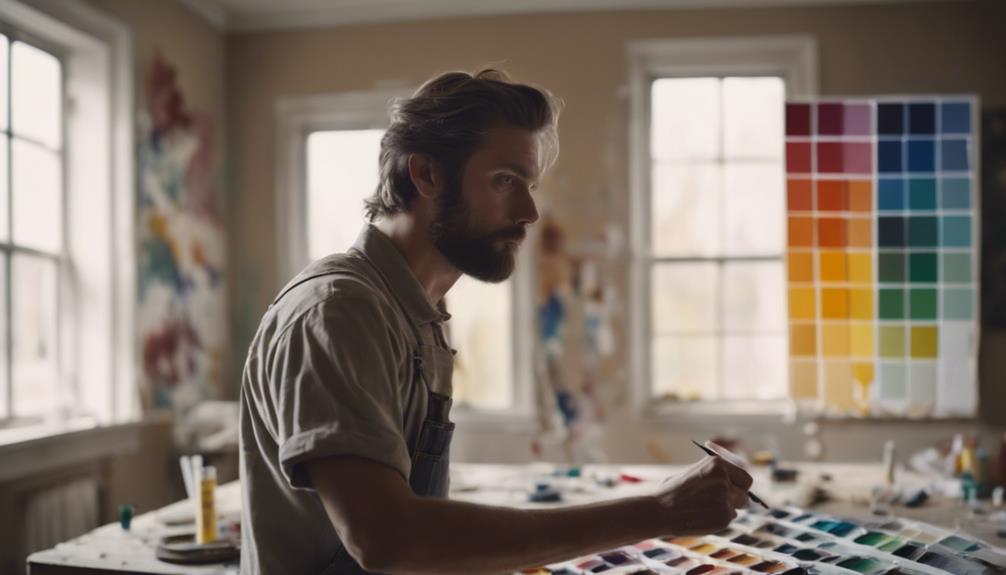
Selecting the perfect paint color for your space involves considering factors like natural light, room size, and desired ambiance. When painting a room, take into account the amount of natural light it receives throughout the day. Lighter colors can make a small room feel more spacious, while darker hues can create a cozy atmosphere.
Utilize color psychology to evoke specific emotions in different rooms; for instance, calming blues work well in bedrooms, while energizing yellows are great for kitchens. Test paint samples on the walls to see how they look in various lighting conditions before making your final decision.
Additionally, consider the existing furniture and decor in the room to guarantee a cohesive look. Consult color wheel principles to create harmonious color schemes, such as using complementary or analogous colors, for a visually pleasing result. By paying attention to these details, you can select the right paint color that enhances the overall feel of your space.
Preparing the Room for Painting
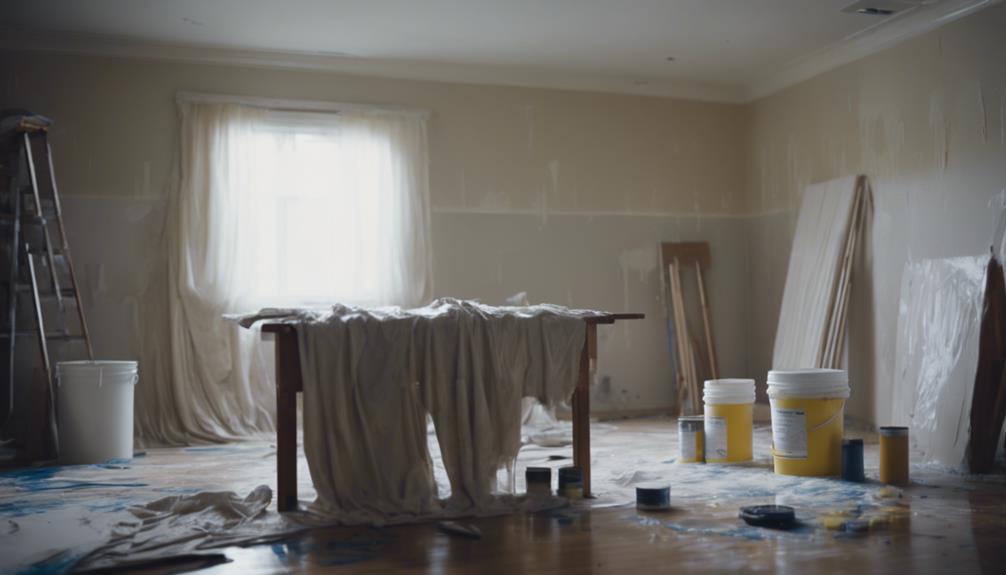
To properly prepare the room for painting, begin by clearing all furniture and covering the floors with drop cloths to safeguard against any paint spills or splatters.
Here are some essential steps to make sure your room is ready for a successful painting project:
- Lay down drop cloths to protect the floors from paint drips and splashes.
- Use painter's tape to protect trim, edges, and fixtures from accidental paint marks.
- Clean the walls to remove dirt, dust, and grease that can impact the paint's finish.
Proper Wall Preparation Techniques
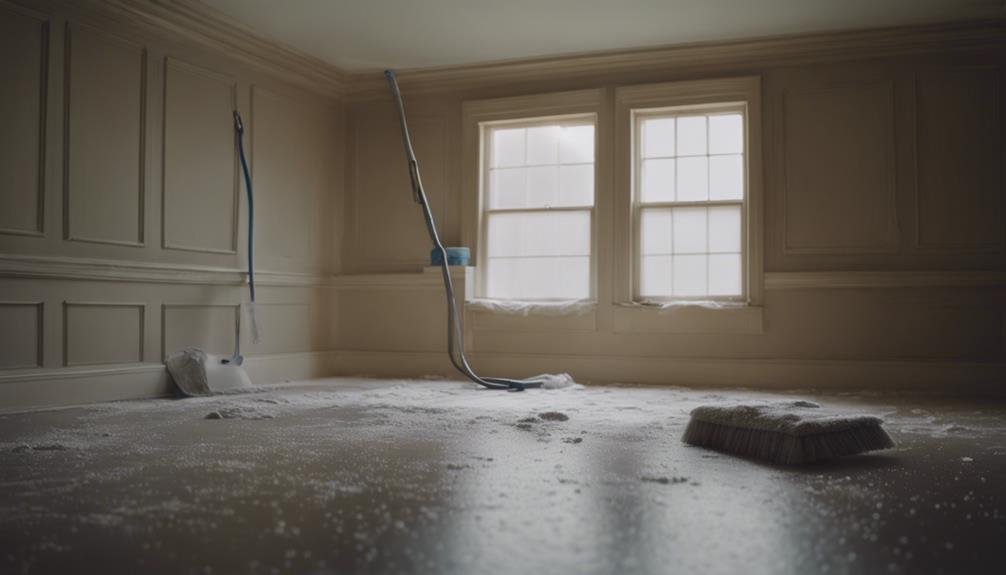
To properly prepare your walls for painting, start by thoroughly cleaning them to remove any dirt or grime.
Next, make sure to repair any damage by filling in holes or cracks with spackle for a smooth finish.
Remember to sand the walls to create an even surface that will help the paint adhere better.
Clean Walls Thoroughly
Prior to painting, guarantee a smooth and long-lasting finish by thoroughly cleaning your walls. To effectively prepare your walls for painting, follow these steps:
- Wash the walls with a mild detergent solution to remove surface contaminants like dust and grease.
- Rinse the walls well to make certain all the cleaning solution is removed.
- For tougher stains or residues, consider using a TSP (trisodium phosphate) solution to clean the walls effectively.
Repair Any Damage
Repairing any damage on your walls before painting is important to achieve a smooth and professional finish. Prior to painting, it's vital to fill in any holes, cracks, or imperfections using spackle and a spackle knife. Smooth out rough spots with sandpaper and guarantee a clean surface with a tack cloth. If needed, spot prime the repaired areas for proper adhesion and paint coverage.
Best Painting Techniques for Interior Walls
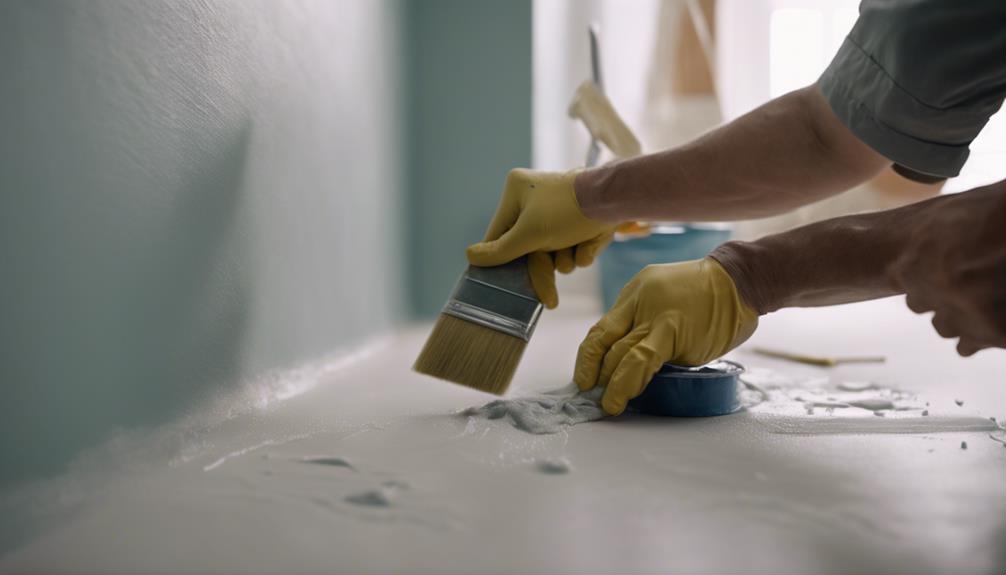
For achieving a professional look on interior walls, using a 'W' or 'M' pattern while painting guarantees consistent coverage.
To guarantee a successful interior painting project, consider the following techniques:
- Multiple Thin Coats: Apply multiple thin coats of paint rather than one thick coat for a smoother finish on interior walls.
- Top to Bottom Painting: Start painting from the top of the wall and work your way down to catch drips and achieve a more even application.
- Proper Drying Time: Allow each coat of paint to dry properly before applying the next layer to prevent smudges and ensure a durable finish.
Tips for Achieving Smooth Paint Application
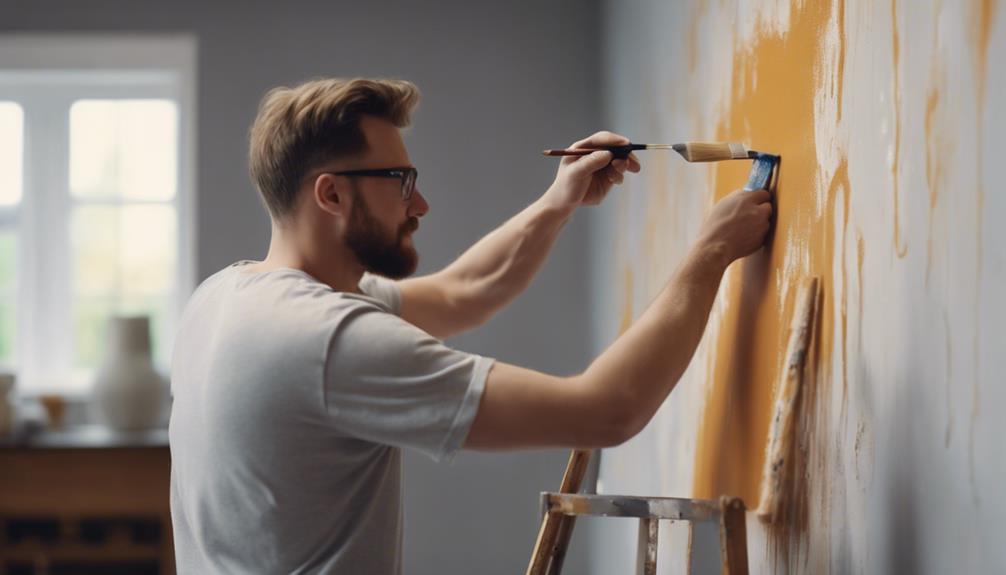
To achieve a smooth paint application, start by thoroughly prepping the surface through cleaning, sanding, and fixing imperfections.
Make sure to select quality paint and tools specifically designed for interior painting to attain a professional-looking finish.
Remember to apply primer before painting and utilize techniques like cutting in and rolling in a 'W' or 'M' pattern for even coverage.
Proper Surface Preparation
Prepare your surfaces meticulously before painting to achieve a flawless and smooth finish. To guarantee successful surface preparation, consider these essential steps:
- Start by scraping off any loose paint or debris.
- Sand the surface to create a smooth and even base for the paint to adhere to.
- Fill in any cracks or holes with spackling compound for a seamless finish.
Overlooking these steps can lead to visible imperfections like roller marks or paint not adhering properly. Additionally, determining how much paint you'll need beforehand can prevent interruptions during the painting process. Covering areas you don't intend to paint with plastic sheeting will safeguard them from accidental splatters.
Choosing the Right Tools
Before you begin painting, making sure you have the right tools is key to achieving a smooth and professional-looking finish on your interior walls. Invest in high-quality brushes and rollers for even paint application. Use a paint tray to access paint easily, guaranteeing a consistent finish. Consider a paint edger for clean lines at edges and corners, enhancing the room's appearance.
Apply multiple thin coats of paint rather than one thick coat to prevent drips and achieve a polished result. Follow the top-to-bottom painting technique to catch drips and ensure thorough coverage on interior surfaces. By using these tools and techniques, you can achieve a smooth paint application and elevate the overall look of your space.
Common Mistakes to Avoid While Painting

One essential step in achieving a successful paint job is ensuring you properly prepare the surfaces before starting. To help you avoid common mistakes while painting, consider the following tips:
- Don't rush the process: Allow each coat to dry completely before applying the next one to prevent uneven coverage and potential damage to the paint.
- Avoid overworking the paint: Applying too many coats or using excessive amounts of paint can result in drips, runs, and an uneven finish.
- Use the right tools: Opt for high-quality brushes and rollers to avoid streaks, brush marks, and an overall unsatisfactory painting experience.
Final Touches and Clean-Up
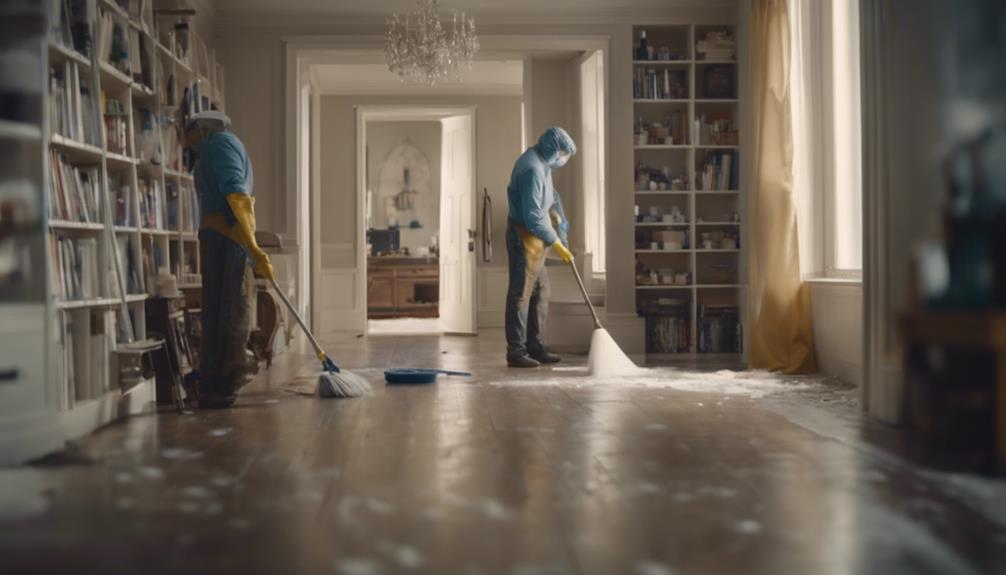
When finishing up your painting project, remember to carefully remove painter's tape to maintain clean lines and avoid peeling off fresh paint. Clean brushes and rollers immediately after use to prevent dried paint buildup and maintain their quality.
Dispose of drop cloths properly to avoid spreading paint residue and keep your work area clean. Reinstall furniture and decor in the room only after the paint has fully cured to prevent accidental damage.
Allow the paint to cure completely before exposing the walls and ceilings to heavy traffic to guarantee a durable finish. Remember to pay attention to details like painting the ceiling to achieve a cohesive look throughout the room.
Frequently Asked Questions
How Hard Is It to Paint Your Own House Interior?
Painting your house interior can seem challenging, but with the right tools and knowledge, it's manageable. Learning basic techniques and seeking advice can simplify the process.
Understanding paint selection and application methods is key. With practice, attention to detail, and patience, you can achieve a successful DIY project.
Prepare, plan, and take your time for a rewarding painting experience.
Is It Difficult to Paint Interior Walls?
Painting interior walls can be straightforward with the right approach. Proper preparation, tools, and techniques are key to making the process easier. By planning ahead, prepping the walls thoroughly, and selecting the appropriate paint, you can simplify the task.
With practice and patience, most homeowners find painting interior walls to be a manageable DIY project. So, roll up your sleeves and give it a try – you might just surprise yourself!
Should I Paint My Interior Myself?
You should definitely consider painting your interior yourself. It's a cost-effective way to personalize your space and gain valuable DIY skills. With the right tools and guidance, the project is manageable and rewarding.
Many homeowners successfully paint their interiors, and you can too. By learning basic painting techniques, you'll feel empowered to take on future home improvement projects with confidence.
Is It Cheaper to Paint Your Own House Interior?
Painting your own house interior is usually cheaper than hiring a professional. For a 10×12 room, DIY costs about $200 to $600, while a professional job can set you back $380 to $790.
By doing it yourself, you control the quality and choose the colors you want. Even though you'll need tools and materials upfront, like brushes and paint, the savings can be significant.
If you're willing to learn and put in the effort, DIY painting is a budget-friendly option.
Conclusion
To sum up, painting the interior of your home can be a straightforward task with the right tools and techniques.
By choosing the correct paint color, preparing the room properly, and using the best painting techniques, you can achieve a smooth and professional finish.
Remember to avoid common mistakes and take care of final touches for a polished look.
With a little patience and attention to detail, you can transform your space with a fresh coat of paint.
Mason – Your Product Expert Mason is your go-to product expert, carefully selecting each item in our collection to ensure it meets your comfort, functionality, and style needs. With his attention to detail and commitment to quality, he ensures that every product we offer enhances your home experience.
Interior
Why Is Interior Painting so Expensive
Nail down the reasons why interior painting is expensive, from premium paint to expert craftsmanship, uncover the true value behind the cost.

Interior painting is expensive due to multiple factors. Quality paint impacts cost greatly, with premium brands like Sherwin Williams and Benjamin Moore offering durability. Skilled expertise is essential for a professional finish, requiring meticulous prep work that justifies the higher pricing. Proper surface preparation guarantees a flawless result, enhancing paint adhesion and longevity. When investing in quality materials, around 15-20% of the total cost could be attributed to paint alone. Experienced painters offer specialized skills, color matching proficiency, and a deep understanding of techniques. The longevity and durability of the results make the investment in interior painting worth it.
Key Takeaways
- Quality paint and materials impact longevity and finish, contributing around 15-20% of total cost.
- Labor intensity involves meticulous preparation, skilled expertise, and attention to detail, justifying higher pricing.
- Surface preparation ensures flawless finish, adhesion, and longevity, highlighting the importance of professional prep work.
- Professional skill and expertise guarantee a polished finish, with specialized techniques and color matching adding value.
- Opting for cheaper bids may compromise quality, while investing in experienced painters justifies the cost for exceptional results.
Factors Affecting Paint Costs
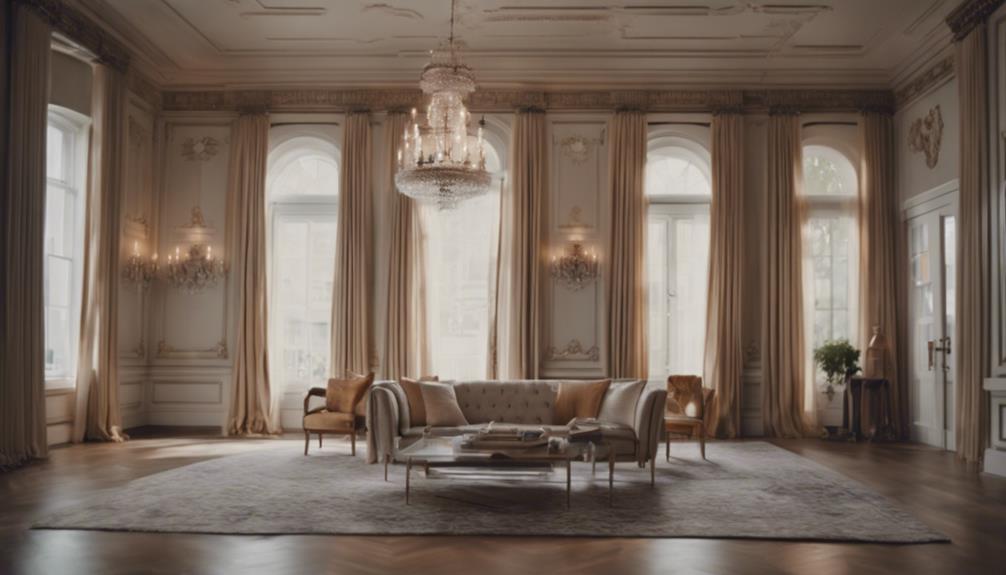
When considering interior painting costs, the factors influencing the price of paint play a pivotal role in determining the overall expense. The quality of the paint used can greatly impact the cost of an interior painting project. Different levels of quality come with varying price points, so it's important to establish your quality expectations and goals upfront. Clear communication of these expectations is important to make sure that you get the desired result without any misunderstandings that could lead to additional costs.
It's important to note that opting for cheaper bids may compromise the quality of the paint job. While it may seem like a cost-effective choice initially, you could end up spending more in the long run to fix any issues that arise from using lower-quality materials. Evaluating the value of overhead costs can also help you understand pricing variations and make an informed decision when selecting the quality of paint for your interior painting project.
Labor Intensity of Interior Painting
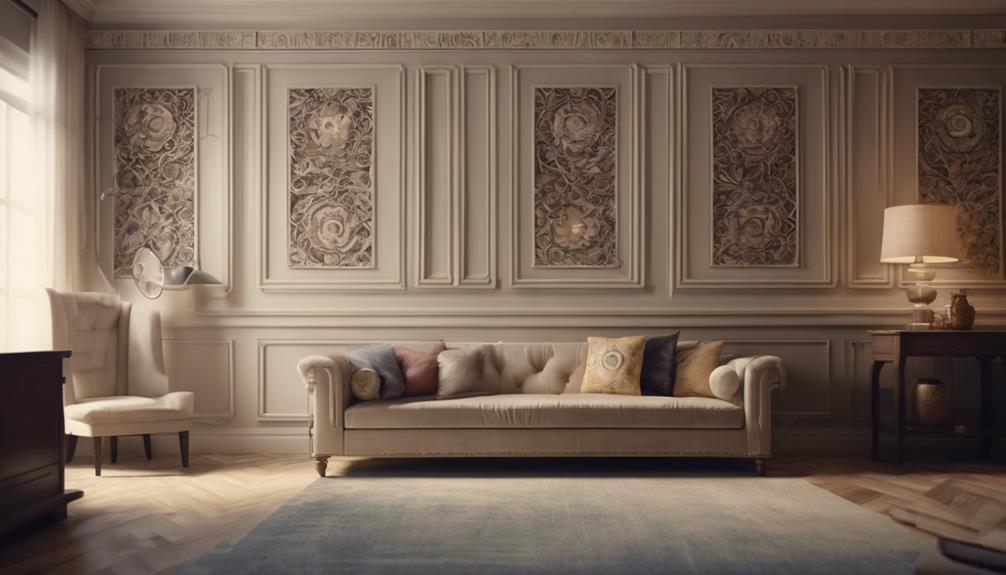
The labor intensity of interior painting demands meticulous preparation and skilled expertise to achieve a professional finish, impacting overall project costs.
Quality paint, prep work, and labor costs are significant components contributing to the expense of interior painting. Skilled labor is vital for ensuring that surfaces are properly prepped, painted, and finished to high standards. Professional painters invest time in sanding walls, filling holes, and applying primer before even starting the actual painting process, which adds to the labor costs.
The time-consuming nature of interior painting, including the application of multiple coats and detailed work, further justifies the higher pricing of this service. The attention to detail, precision, and expertise required in interior painting highlight the importance of hiring professionals for the job.
Impact of Surface Preparation

Proper surface preparation plays a pivotal role in achieving a flawless and durable interior paint finish. When it comes to painting your walls, surfaces need to be meticulously prepared to guarantee the paint adheres properly and lasts longer. Surface preparation involves tasks like sanding, filling holes, and applying primer to create a smooth canvas for the new paint. Professional painters emphasize the importance of thorough surface preparation as it not only enhances the final look but also contributes to the longevity of the paint job, reducing the need for frequent touch-ups or repainting.
Investing in professional surface preparation might seem like an added cost, but it ensures a high-quality finish that justifies the expense. Without proper preparation, surface imperfections can affect the paint quality and overall appearance of your walls. The time, skill, and specialized tools required for thorough surface preparation contribute to the overall cost of interior painting but result in a smooth, long-lasting paint job that you'll enjoy for years to come.
Quality of Paint and Materials
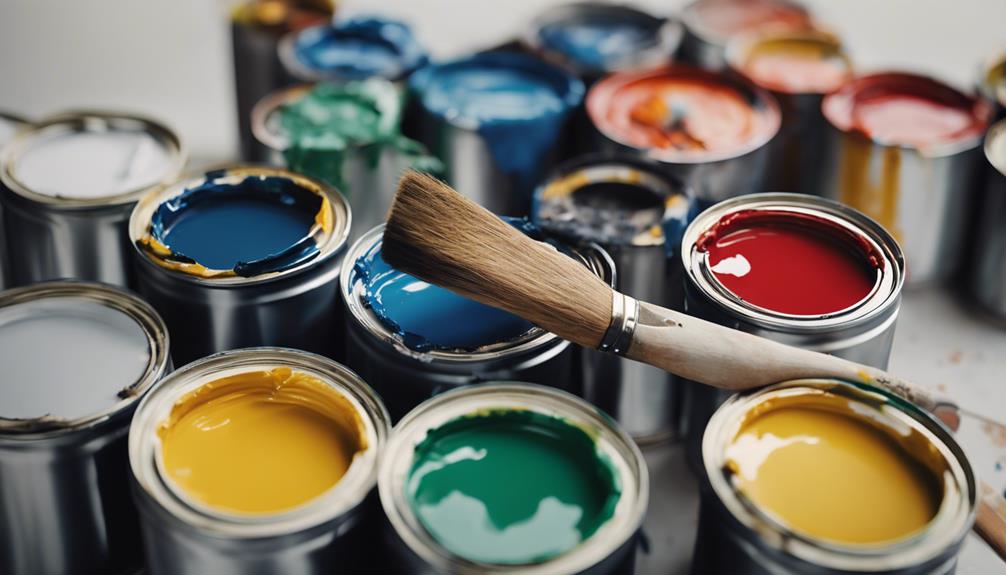
Investing in high-quality paint and materials for your interior painting project can greatly impact the overall cost and longevity of the finish. Higher quality paint may contribute to around 15-20% of the total painting cost, but it's worth it in the long run.
Premium brands like Sherwin Williams and Benjamin Moore are renowned for their durability and impeccable finish, ensuring your walls look stunning for years to come. Quality materials not only provide better coverage but also enhance adhesion, making sure the paint stays put.
Professional Skill and Expertise
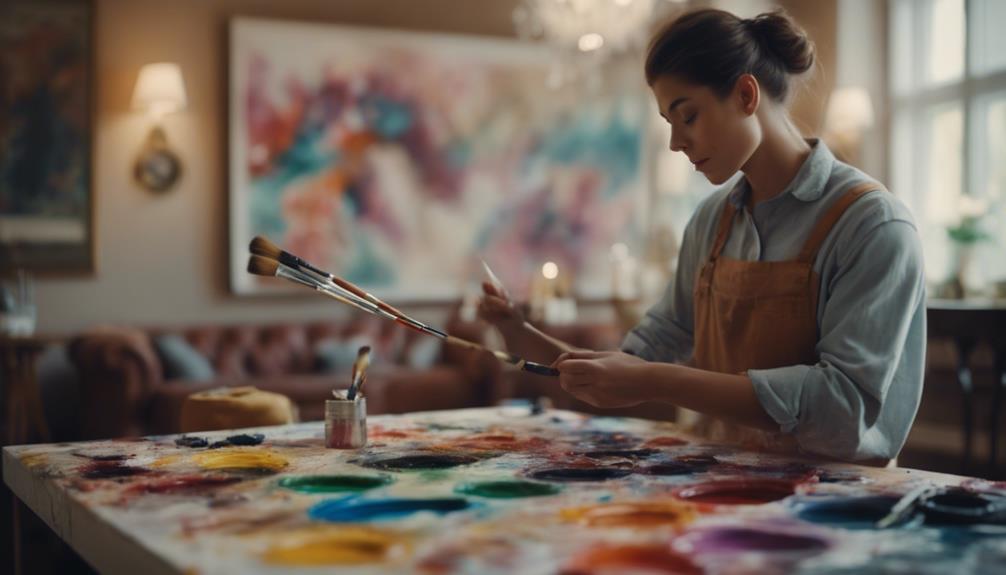
Experienced painters bring a level of precision and efficiency to your project that guarantees a professional and polished finish. Their specialized skills and expertise ensure a high-quality result that can only be achieved through years of practice and training. When you hire professional painters from reputable painting companies, you're investing in a professional paint job that will stand the test of time.
Professional painters possess a deep understanding of various painting techniques and best practices. They can efficiently handle complex tasks like intricate designs or textured surfaces, thanks to their knowledge and experience. Additionally, their expertise in color matching and application techniques adds significant value to the final result, ensuring a flawless outcome that enhances the overall aesthetics of your space.
While the cost of hiring professional painters may be higher, their training and experience justify the investment by delivering exceptional results that exceed your expectations. Trusting skilled professionals for your painting project guarantees a job well done and a beautifully finished space.
Longevity and Durability of Results
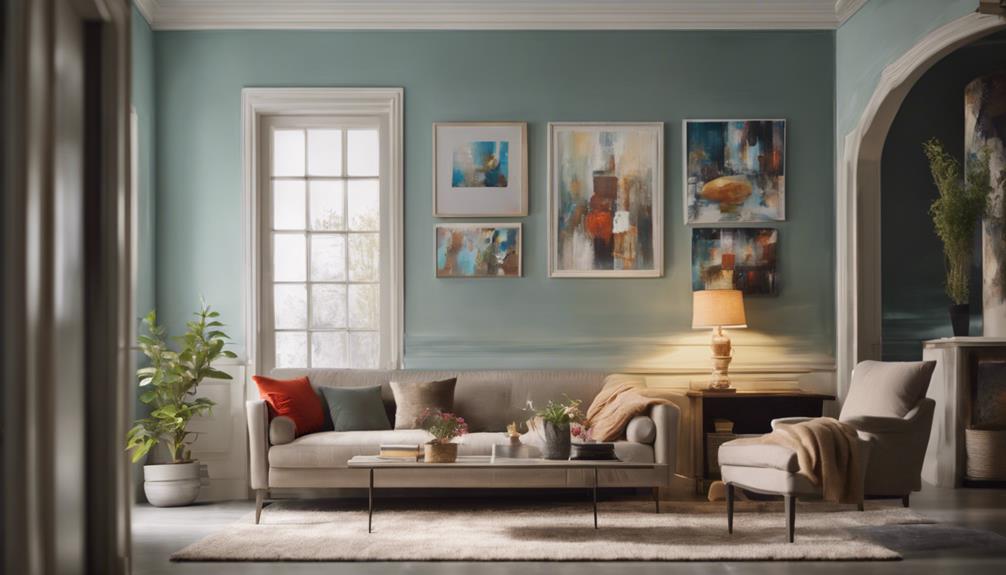
To guarantee a lasting and durable interior paint job, prioritize the longevity and durability of the results by investing in quality materials and skilled labor.
Quality materials play an essential role in the longevity of your interior paint. Opting for high-quality paint ensures that your walls not only look great but also maintain their appearance over time. When paired with proper application techniques, quality paint can protect your walls against wear and tear, increasing their durability.
Professional painters understand the importance of longevity and durability. By utilizing techniques that prioritize durability, they create a finish that can withstand daily use and cleaning, ensuring your paint job lasts.
Investing in premium materials and skilled labor might increase the initial cost of the paint job, but it leads to a finish that adds long-term value to your property. By focusing on durability and longevity, you can enjoy a beautifully painted interior that requires less frequent repainting, ultimately saving you time and money in the long run.
Frequently Asked Questions
Why Does Interior Painting Cost so Much?
Interior painting costs so much due to various factors. The labor-intensive prep work like sanding and priming, high-quality materials, and skilled painters all contribute to the expense.
Professionals use specialized techniques and tools, adding value to their service. Overhead costs and the time-consuming nature of the job also justify the price.
When you invest in quality interior painting, you're paying for expertise, durability, and a beautifully finished space.
Is It Cheaper to Paint Your Own House Interior?
Painting your own house interior can be cheaper, but it requires time and effort. You'll save on labor costs, but the quality may not match professionals.
For example, by tackling the project yourself, you could save hundreds of dollars. However, be prepared for a time-consuming task that demands attention to detail.
Consider the trade-offs between cost savings and the level of finish you aim to achieve.
Is Expensive Interior Paint Worth It?
When it comes to interior paint, splurging on a pricier option can be worth it. Expensive paint offers better coverage, durability, and color retention than cheaper alternatives.
The higher levels of pigments and resins in premium paints enhance color richness and finish longevity. Investing in quality paint guarantees a smoother application, better adhesion, and longer-lasting results for a superior finish in your space.
It's a smart choice for a lasting and satisfying outcome.
Why Is Paint Getting so Expensive?
Paint prices are skyrocketing for various reasons. Factors like increased raw material costs, eco-friendly paint formulations, and the demand for top-tier brands all play a role.
Technological advancements and quality assurance measures also contribute to the hefty price tags.
Conclusion
To sum up, interior painting may seem expensive, but it's worth the investment for a fresh and long-lasting look.
Just like buying a high-quality pair of shoes may cost more upfront, but they'll last longer and keep your feet happy.
So, think of interior painting as the stylish makeover your home deserves – a little pricey now, but totally worth it in the long run!
Home Decor
Where Can I Find Quirky Home Decor
Wander through diverse online and offline platforms for quirky home decor that will ignite your imagination and transform your space.
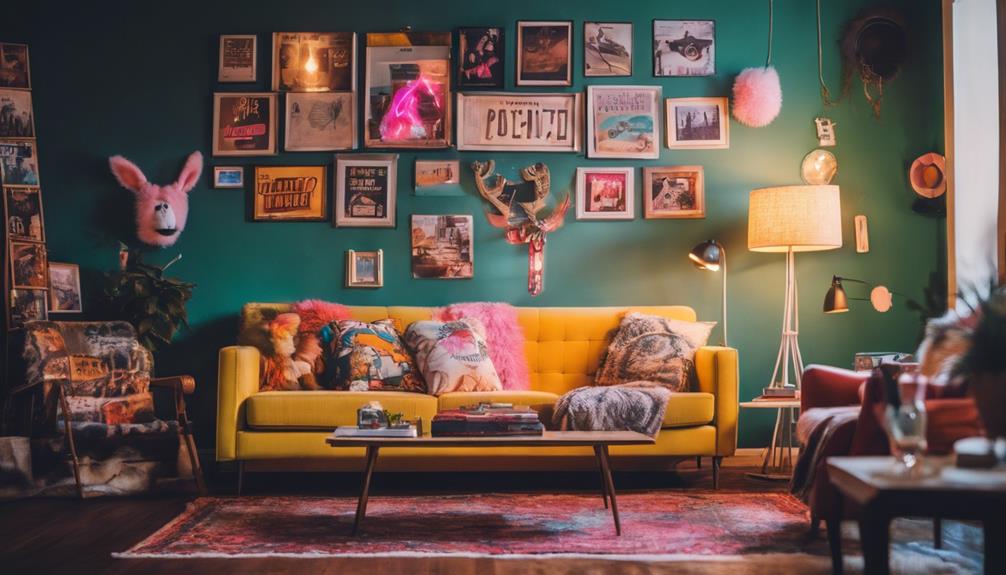
When exploring for quirky home decor, delve into the wonders of online platforms like Etsy for unique items such as 'Weird Wall Art' and 'Dopamine Decor'. Additionally, boutique shops and flea markets offer handcrafted and affordable treasures, while local artisan fairs and vintage stores provide one-of-a-kind pieces. Pop-up markets and independent artists' websites showcase diverse selections with sustainable practices. Immerse yourself in the world of Instagram, Pinterest, TikTok, and Facebook groups for more inspiration and tips. Uncover hidden gems in retro furniture, funky wall art, and vintage lamps that add character to your space.
Key Takeaways
- Check online platforms like Etsy for unique and unconventional items.
- Explore boutique shops for handcrafted and whimsical decor pieces.
- Visit flea markets for affordable vintage and retro finds.
- Attend local artisan fairs for one-of-a-kind, personalized decor.
- Browse vintage stores for eclectic and sustainable home decor treasures.
Online Specialty Stores
When we're looking for unique and unconventional home decor items, online specialty stores like Etsy offer a diverse selection of quirky pieces that cater to individual tastes and preferences. Etsy is a hub for handmade and specialized gifts, making it a go-to for those seeking eclectic and unconventional farmhouse decor.
The platform's 'Weird Wall Art' and 'Dopamine Decor' shipping categories cater to those with a taste for the extraordinary. Handmade housewarming gifts and farmhouse decor are particularly popular among shoppers looking to add a touch of individuality to their living spaces.
Quirky home decor gifts like the 'Anemone Planter Maximalist Colorful' and 'Cute Drainage Trays' showcase the creative and unique offerings available on Etsy. For those wanting to infuse their homes with a fun and unconventional vibe, Etsy's selection of items like 'Metal Fish Wall Art' and 'Seasons Art theme' provide endless possibilities to express personal style.
Boutique Shops

Boutique shops specializing in quirky home decor offer a distinct array of unique and eclectic pieces not commonly found in mainstream stores. These shops showcase handcrafted items, vintage treasures, and one-of-a-kind pieces that bring charm and individuality to any living space. With a focus on creativity and unusual design aesthetics, quirky home decor boutiques cater to customers seeking a different kind of style.
Many boutique shops curate a selection of whimsical, fun, and unconventional home decor items, appealing to those looking to add a touch of personality to their homes. By shopping at these stores, customers not only find distinctive pieces but also support small businesses and artisans. This unique shopping experience allows individuals to express their creativity and originality through the decor choices they make.
Flea Markets
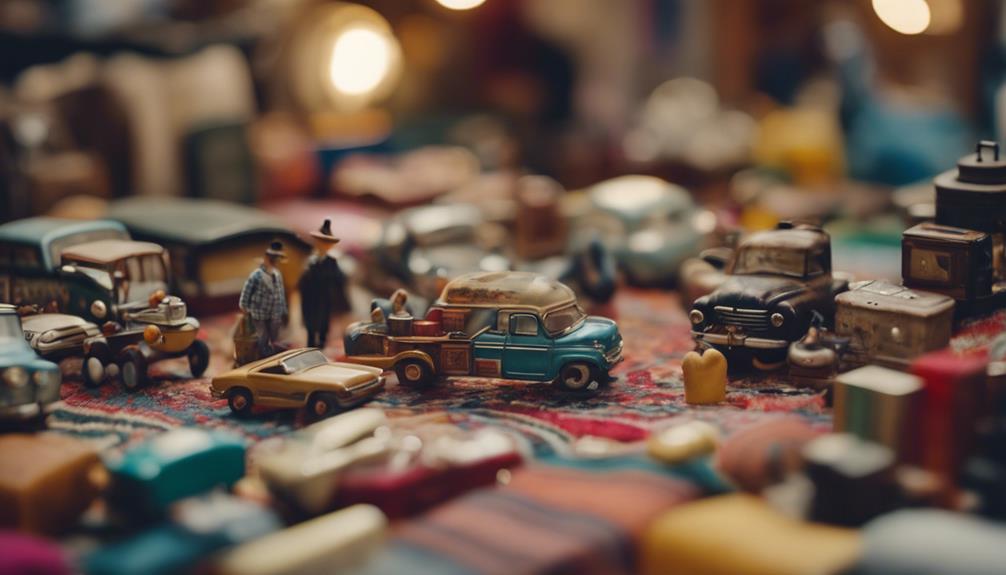
Flea markets offer a treasure trove of quirky home decor items at affordable prices, making them popular destinations for those seeking unique and eclectic pieces. These markets are known for their vintage and retro offerings, providing a wide array of eclectic decor options that can add character to any home.
Shoppers often stumble upon hidden gems at flea markets, discovering one-of-a-kind pieces that aren't typically found in traditional stores. Bargaining is a common practice at flea markets, allowing buyers to negotiate prices and snag deals on quirky decor pieces.
The affordability of items at flea markets makes them ideal for those looking to decorate their homes with distinctive and eye-catching pieces without breaking the bank. Whether you're searching for a statement piece or small accents to enhance your space, flea markets are sure to have a unique selection of quirky home decor items to suit your style.
Local Artisan Fairs

Local artisan fairs showcase a variety of unique home decor items crafted by talented local artisans. These fairs offer a chance to support small businesses while adding one-of-a-kind pieces to your home decor collection.
Handmade items not typically found in mainstream stores provide a special flair to your living space.
Artisan-Made Unique Finds
Exploring artisan-made unique finds at local fairs offers a delightful journey into the world of handcrafted home decor. These events showcase quirky and eclectic decorative accents, ranging from funky wall art to exclusive pieces not found in mainstream stores. Local artisan fairs provide a platform for talented individuals to display their one-of-a-kind, artisan-made items.
By browsing these fairs, visitors not only discover unique home decor but also have the chance to support local artists directly. The artisan-made quirky home decor available at these fairs adds a personalized touch to any living space while fostering creativity within the community.
Embracing these exclusive pieces not only enhances your home but also contributes to the vibrant tapestry of local artistry.
Support Local Talent
Discovering the vibrant array of unique and quirky home decor items at artisan fairs is an enriching experience that celebrates local talent and creativity. Attending these fairs not only allows you to find personalized and exclusive pieces for your home but also supports the talented individuals in your community.
When you explore artisan fairs, you can:
- Uncover handmade treasures that are one-of-a-kind
- Connect with the creators behind the quirky decor pieces
- Discover decor items that are truly unique
- Explore a diverse range of personalized home decor products
- Support local talent and contribute to the community's creative spirit
Handcrafted One-Of-A-Kinds
At artisan fairs, we can uncover an array of handcrafted one-of-a-kind quirky home decor pieces that add a unique touch to our living spaces. Local artists showcase their creativity through a diverse selection of items, including wall art and functional pieces like vases and sculptures.
These quirky home decor pieces are exclusive and not typically found in mainstream stores. By supporting local makers at artisan fairs, we contribute to the growth of the creative community and discover hidden gems that reflect the individuality of the artists.
Shopping at these events not only allows us to find unique decorations for our homes but also enables us to connect with the stories behind each handcrafted piece.
Vintage Stores
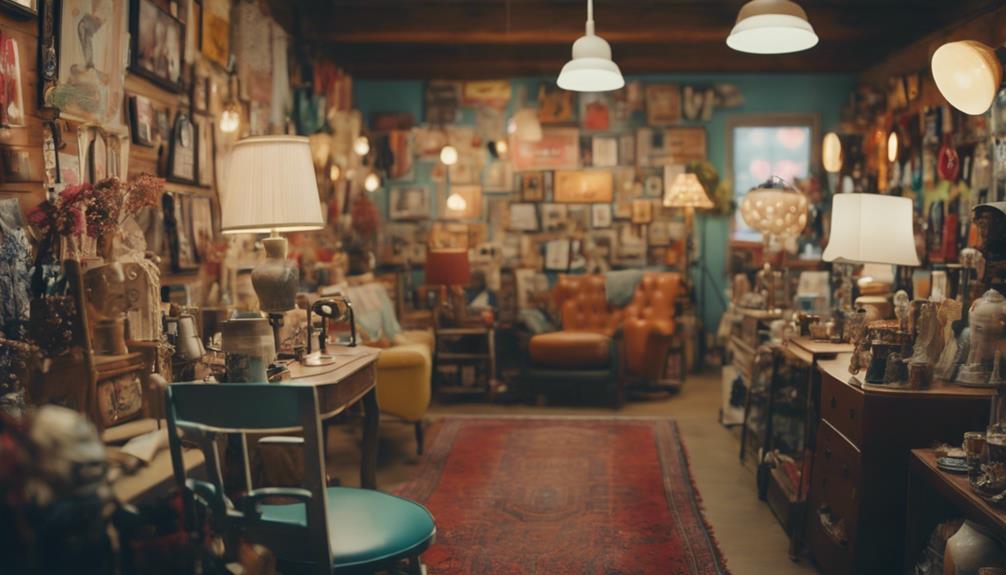
Vintage stores are treasure troves filled with unique and quirky home decor pieces that can add a touch of character to any room. These stores offer a diverse selection of vintage treasures, from retro lamps to funky accessories, catering to eclectic decor styles.
Explore and uncover one-of-a-kind items like ceramic vases, abstract trays, and artistic wall accents hidden within the shelves of vintage stores.
Unique Finds Unearthed
Discovering unique finds at vintage stores reveals a world of eclectic and nostalgic home decor options.
- Retro lamps
- Funky rugs
- Eclectic glassware
- Artistic home accents
- Individuality
Vintage stores are treasure troves filled with one-of-a-kind pieces that can add character and charm to any living space. From retro lamps that bring a touch of the past to funky rugs that make a bold statement, these stores offer a diverse range of items to suit various tastes.
The eclectic glassware and artistic home accents found in vintage stores are perfect for those looking to infuse their decor with personality and nostalgia. Embrace your individuality by exploring the unique treasures waiting to be unearthed in vintage stores.
Hidden Gems Discovered
Unearthing hidden gems in vintage stores can transform your home decor into a unique and eclectic masterpiece. When browsing through these stores, you'll come across a plethora of one-of-a-kind items that exude a quirky charm perfect for adding character to your living space. Vintage stores are like treasure troves, offering an array of eclectic pieces that you won't find in mainstream stores. By choosing pre-loved items from these stores, you're not only creating a distinctive home environment but also contributing to sustainability by giving new life to old treasures. These unique finds serve as excellent conversation starters, elevating your decor with their history and individuality. Explore these hidden gems and let your home tell a story.
| Vintage Stores | Conversation Starters | Sustainability |
|---|---|---|
| Unique Home Decor | Quirky Items | Hidden Gems |
| One-of-a-Kind | Eclectic Finds | Pre-Loved Items |
Eclectic Treasures Await
Exciting treasures filled with character and history await at vintage stores, offering a diverse selection of unique and one-of-a-kind home decor items. When exploring these eclectic havens, you may stumble upon:
- Retro furniture pieces that add a nostalgic touch to your space.
- Funky wall art that serves as a conversation starter.
- Unusual accents like vintage lamps or quirky figurines to showcase your personality.
- Items sourced from estate sales, auctions, and flea markets, ensuring a mix of styles and eras.
- A commitment to sustainable practices, as shopping at vintage stores gives new life to pre-loved items and supports eco-friendly decor choices.
Pop-up Markets
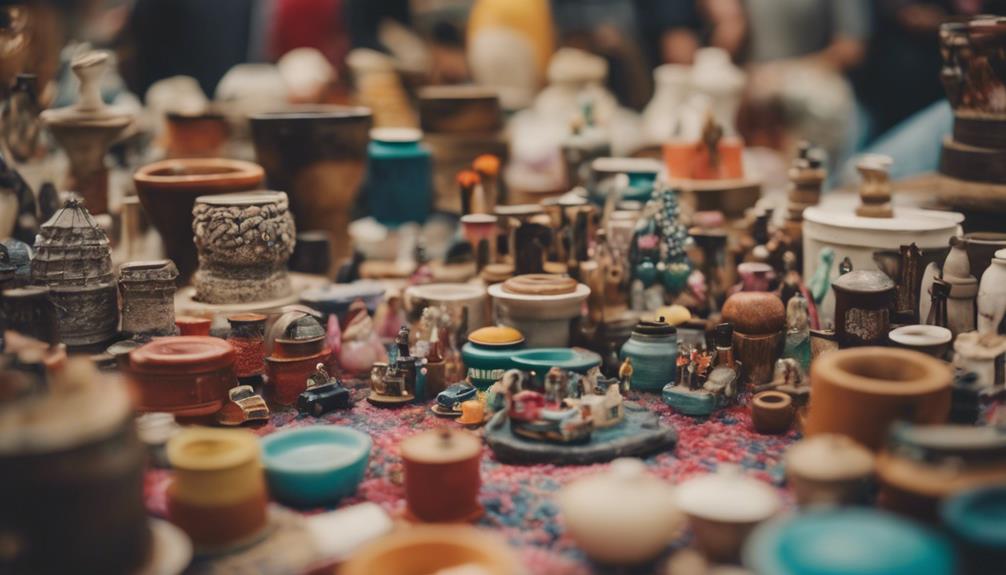
In our quest for unique home decor pieces, we often stumble upon pop-up markets, temporary retail spaces showcasing the creativity of local artisans and designers. These markets provide a platform for small businesses to display their handmade products, offering a diverse selection of quirky home decor. Customers can expect to find a wide range of unconventional and eye-catching pieces at these markets, making them a treasure trove for those in search of unique items.
Pop-up markets are known for creating a vibrant and dynamic shopping experience. Shoppers have the opportunity to interact directly with creators, gaining insight into the inspiration behind the pieces on offer. These markets can be found in various locations, from empty storefronts to outdoor spaces and event venues. Whether you're looking for a statement piece for your living room or a quirky addition to your kitchen, pop-up markets are sure to have something that catches your eye.
Independent Artists' Websites
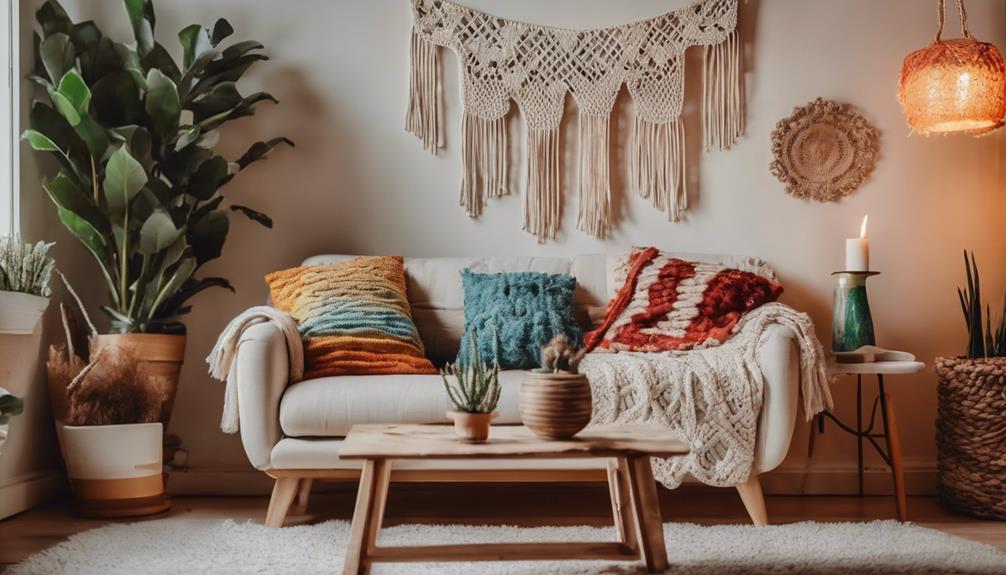
Perusing independent artists' websites like Etsy reveals a diverse array of quirky home decor items crafted by talented individuals. These platforms offer a unique shopping experience where you can discover handmade and unconventional pieces that bring a creative flair to your living space. Here are five reasons why exploring independent artists' websites can elevate your home decor:
- Find one-of-a-kind items that add a personal touch to your space.
- Support small businesses and independent artists with your purchases.
- Discover unique items that aren't typically available in mainstream stores.
- Enjoy the creativity and craftsmanship of talented individuals who pour their passion into each creation.
- Add a conversation starter to your home with quirky and unconventional decor pieces that stand out.
Social Media Platforms
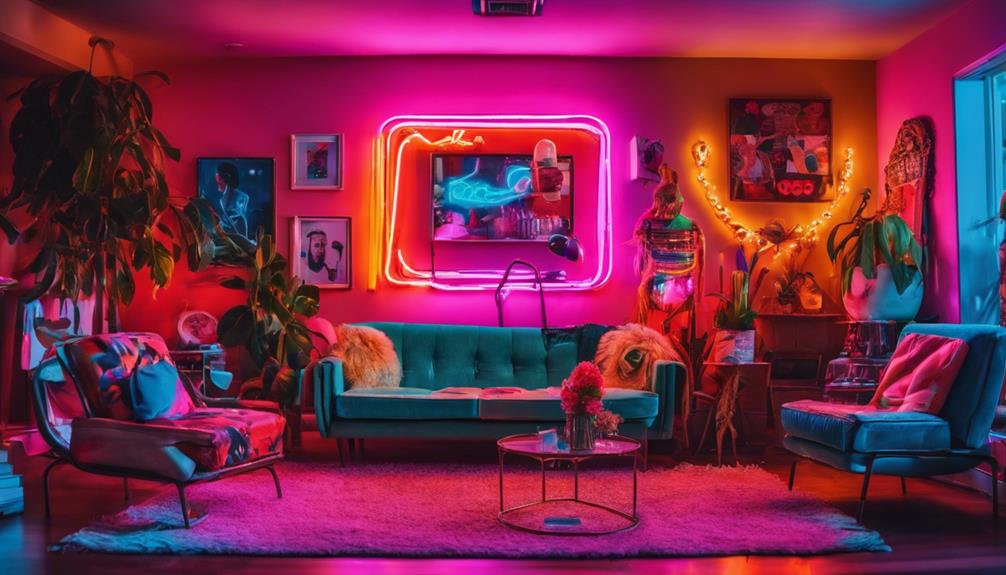
After exploring independent artists' websites for unique home decor, turning to social media platforms can provide additional avenues to discover quirky and unconventional design inspirations. Instagram, known for its visually appealing content, is a popular platform for finding quirky home decor. By following hashtags like #quirkyhomedecor and dedicated accounts, you can stumble upon a plethora of unique ideas.
Pinterest, on the other hand, offers a treasure trove of quirky home decor ideas and DIY projects through its boards and pins showcasing eclectic and unusual designs. TikTok, with its short videos and trends, has a growing community of creators sharing quirky home decor tips and shopping recommendations.
Additionally, Facebook groups focused on home decor enthusiasts often share unique and quirky finds, along with recommendations for offbeat decor stores and online shops. Engaging in Twitter chats and conversations surrounding home decor trends can also lead to discovering niche brands and artists specializing in quirky and unusual home decor pieces.
Frequently Asked Questions
What Is the Most Sold Home Decor?
The most sold home decor items on Etsy are the Rose Family Inspired Balloons Creek Birthday Party Decor and the Snake with flower crown plant pal accessory, with both being popular quirky choices. These unique pieces cater to those seeking distinctive home decor accents that add a touch of whimsy and personality to their living spaces.
Etsy's platform showcases a diverse array of creative and handcrafted items that appeal to a wide audience looking for something special.
How to Do Dopamine Decor?
To do Dopamine Decor, focus on:
- Bold colors
- Unique designs
- Quirky accents
Create a visually stimulating space that evokes joy and excitement. Incorporate:
- Eclectic pieces
- Vibrant artwork
Reflect your personality and style. Aim for a lively and dynamic environment inspired by the neurotransmitter dopamine, associated with pleasure and reward.
How Can I Make My Home Decor Beautiful?
To make our home decor beautiful, we combine unique elements like resin night lights, metal wall art, and handmade paper foldable lamps for a personal touch.
Seeking specialized pieces such as custom garden decor and ceramic art tiles adds a one-of-a-kind flair.
Exploring niche categories like 'Weird Wall Art' on platforms like Etsy can uncover unconventional options.
Trendy items like positive affirmations prints and vintage wall art enhance our space with style and charm.
How Can I Decorate My Home in Style?
When decorating our home stylishly, we focus on incorporating unique and quirky decor items like resin night lights, metal wall art, and handcrafted paper lamps for a chic touch.
We explore specialized pieces such as custom garden decor, ceramic art tiles, and teal wall clocks to infuse personality into the space.
Trendy wall decor items like vintage prints, giclée art, and twist vases from the Meadow Collection offer a fashionable look.
Conclusion
So, if you're looking to spruce up your living space with some unique and quirky decor, there are plenty of options to choose from.
Whether you prefer shopping online, exploring local markets, or supporting independent artists, there are endless possibilities to find that perfect conversation starter for your home.
So go ahead, let your creative side shine and discover the hidden gems waiting to be found in the world of quirky home decor.
-

 Decorative Throws2 weeks ago
Decorative Throws2 weeks agoIs It Better to Dry Clean Blankets?
-

 Yarn2 weeks ago
Yarn2 weeks agoIs Yarn Natural or Manmade? Unravel the Truth
-

 Decorative Throws2 weeks ago
Decorative Throws2 weeks agoWhat Wattage Is an Electric Throw
-
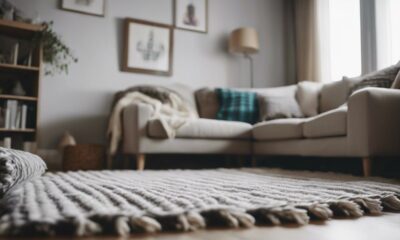
 Decorative Throws2 weeks ago
Decorative Throws2 weeks agoCan I Use a Throw Blanket as a Rug
-
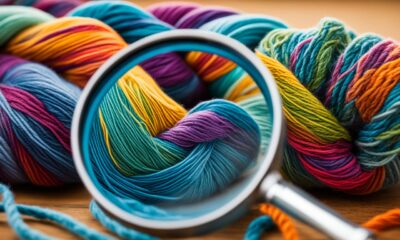
 Yarn2 weeks ago
Yarn2 weeks agoUnravel the Mystery: Why Are Yarn Specs a Secret?
-

 Craft and Textiles2 weeks ago
Craft and Textiles2 weeks ago15 Best Battery-Powered Leaf Blowers for Effortless Yard Work
-

 Tableware and Dining Accessories2 weeks ago
Tableware and Dining Accessories2 weeks agoWhat Is the Meaning of the Word Tableware
-

 Craft and Textiles2 weeks ago
Craft and Textiles2 weeks ago15 Best Toast Recipes to Start Your Day Right















